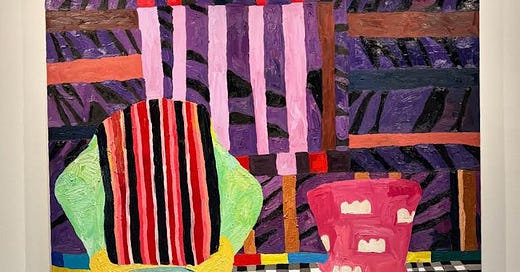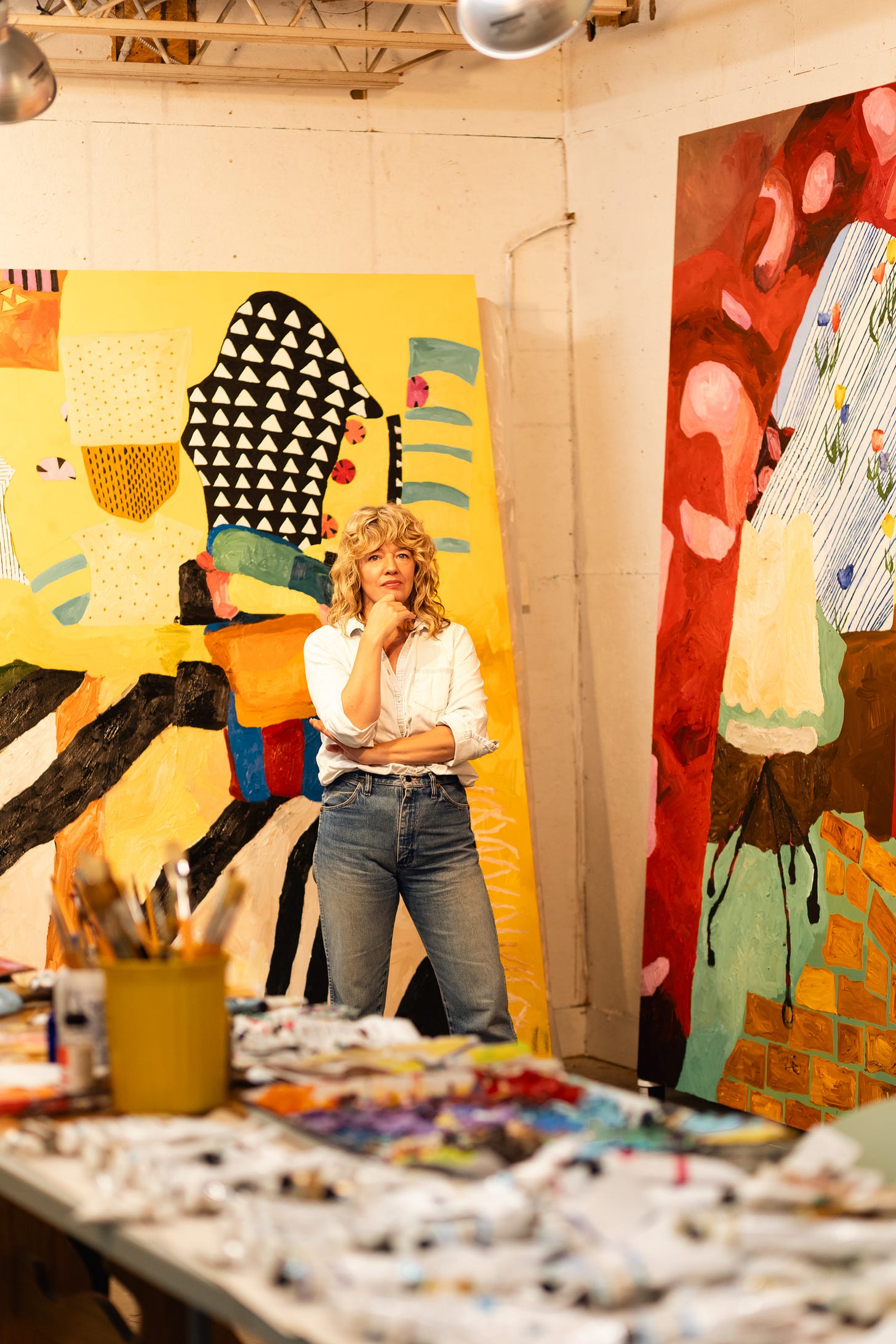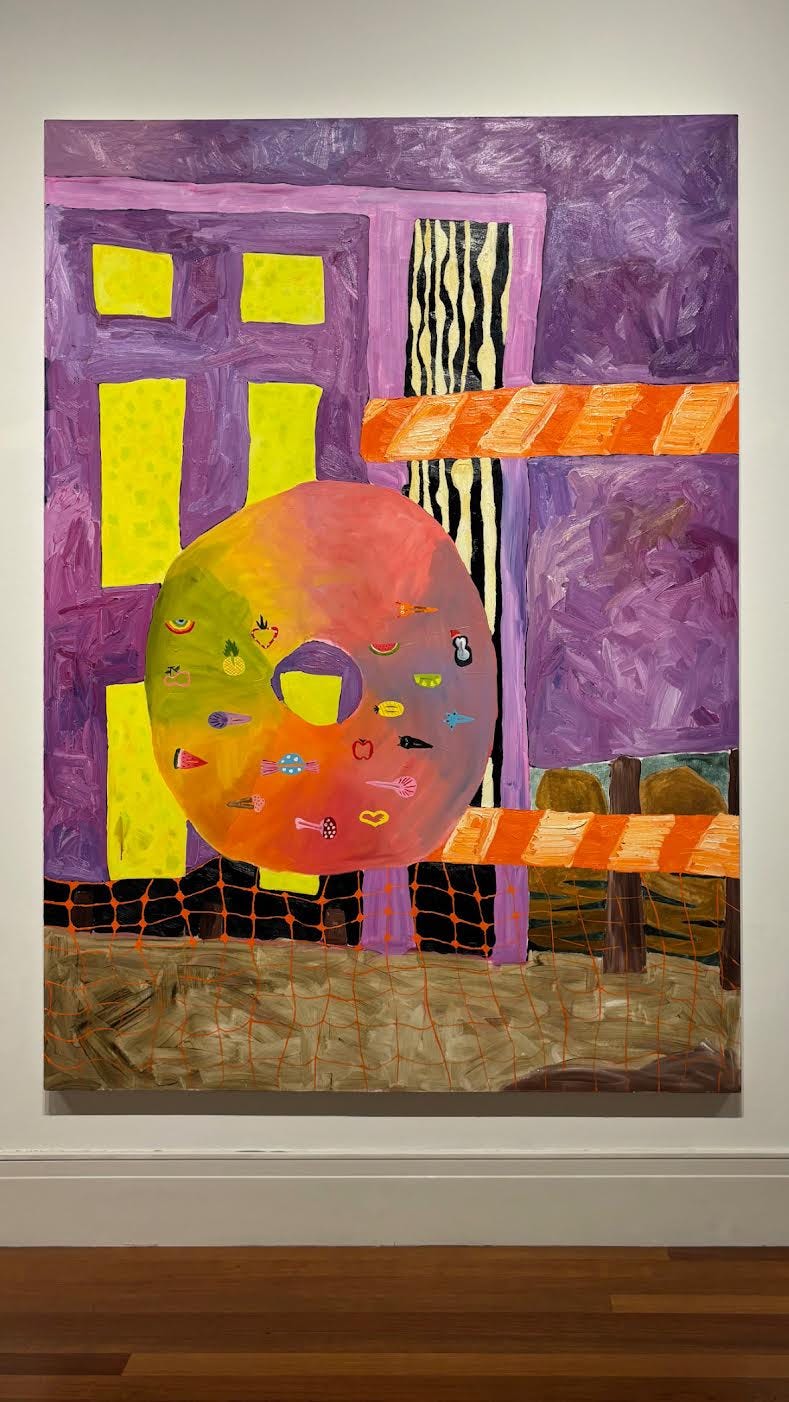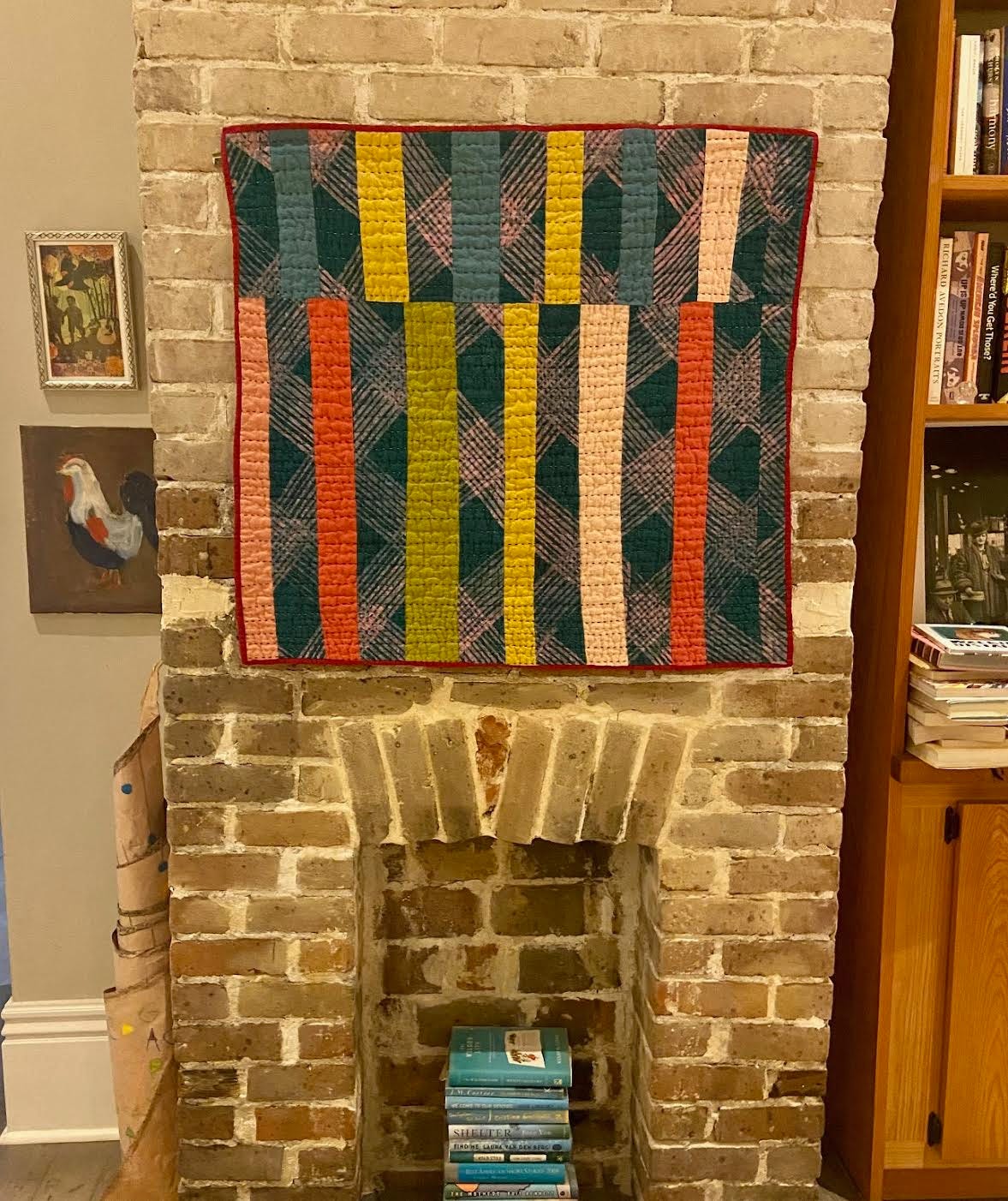Hi friends.
Brooke Pickett is one of my favorite artists. She’s also my friend. She makes dazzling, wildly colorful large-scale paintings that interrogate big ideas about climate change, domesticity, and destruction. She makes quilts that I want to wrap myself inside. And she is a person I always look for on Mardi Gras Day because of her exceptional costumes.
Since I have known her, she has contended with dramatic career shifts, new parenting, and long-term displacement because of Hurricane Ida. Yet she always returns to her artistic work—she is always making something—and still has the time to encourage other people to make their work, too. She is as obsessed with process as I am, and I love our conversations about making our art. She is one of my personal inspirations.
I interviewed her in honor of her big, breathtaking, revelation of a show at the Ogden Museum of Southern Art as part of the Prospect New Orleans triennial P.6. We talked about how she knows when she’s done with a painting, what she needs from a workspace, which poems inspire her, and what it feels like to (re)emerge as an artist in her 40s.
Let’s talk first about your process. How do you decide on a theme for a show? Is it one piece first that leads to another or is it a big idea you're working on all along?
Sometimes I start with a list of titles. Sometimes it’s a persona I want to try on. For the last couple of years it's been a combination of No Grid Survivalist meets 19th century theories of Home As Promised Utopia. I’ve been interested in the politics and themes around home, domestic spaces, and the promises of safety for a long time. Sometimes I’m more aware of it than others, but it’s been an undercurrent in my work for 15-20 years.
The process for making the paintings, and in a sense understanding what I’m thinking, begins with foraging and collecting. I build still lifes and installations in my studio made up of discarded and abandoned domestic objects. I’m really interested in mending broken things, and the transformation that occurs when you try to physically repair something that can no longer serve its original purpose.
For my show that is up right now, I collected items like textiles, ironing boards, toys, laundry baskets and then arranged them into big dioramas in my friend's basement. At the time, we had just finished rebuilding our home post-Hurricane Ida and the arranging of other people’s objects in interior spaces felt performative in the best way. I likened it at the time to rearranging furniture on a sinking ship. But it’s also about the level of dissociation required to rebuild in a sinking city. I knew I had a lot to say about being a mom and raising a small child in the face of ecological disaster.
But also, I love my home and the rituals that come with it. Performing domesticity, saving and repairing abandoned objects, rearranging someone else’s toys help me sort my thoughts and feelings on several of these ideas. I documented all of the installations I’d made and then identified 10 or so that I wanted to monumentalize into large paintings.
The process of making large oil paintings of what are essentially temporal, fragile things is very satisfying to me, like making broken things unbreakable. Yes, it’s about the vulnerability of our things, but also all the hopes and dreams we place on and inside our things, and what our belongings say about us, how what we choose to live with our things begins to tell the story of us.
How much does consuming other culture play into your work?
While working on these paintings I read a lot. I started with Soil by Camille Dungy. I love her work, and even named a painting after her collection of poetry “What To Eat, What To Drink, What To Leave For Poison.” I also read weird survivalist manuals about building your own radio, along with research on underground mutual aid, and alternative networks of care. I build playlists that help me get into the mindset I want to maintain while in the studio, and I look at a lot of art.
How you know when you're done with a piece and/or body of work?
I know that a painting is done (for me) when it’s 70% beautiful and 30% still ugly. When parts of it hold their own, and parts seem like they could unravel at any moment. When the space seems like the floor could bottom out, or a wall could collapse in on itself. I don’t like easy solutions, perfect endings, or precious paintings so I work hard to keep them from being any of those things. I also love the challenge of making unconventional palettes work together, and I try to never use the same combination of colors twice.
"How To Make Drinkable Water Out Of Air”
Can you tell me a bit about your workspace? I know you've had a few over the years, and two in particular for this show you just finished. Can you talk about what your needs and wants are in a workspace? Do you have clean walls, do you have images up for inspiration?
I have a 700 square foot space right now that I love. I need a space that is light and bright, relatively clean, and big enough to hold large paintings. I prefer a space outside of my home, so I can let the demons out and then leave them when it’s time to go home. On the walls I have poetry that help me remember who I am, working titles for pieces, and maybe some deadlines. (For a while I had a sheet of paper up that read: “May + June FUCK IT UP, July + August CLEAN IT UP” to help me remember how to finish the work.)
I also need privacy. That’s probably the most important element. I start my studio days by dancing with my eyes closed. It’s not uncommon for me to cry at some point, I need to feel like I can do anything necessary to make the work, and that I can do it safely and privately.
While I didn't know you in your twenties and early thirties, I have an understanding that you were more actively pursuing the career of an artist and then there was a break where you took on different day jobs and became a parent. You were always making work along the way but now, in your forties, you're throwing yourself back in it with what seems like a new and special fire.
I went to grad school at 22 or 23 because I knew how to paint, but not much about contemporary art. I finished my MFA at 25 and had a steady career and studio practice for over a decade. I was showing my work regularly until the 2016 election broke my heart and my brain. Suddenly making paintings in the wake of multiple global crises seemed futile, even indulgent.
Over the course of 3 years there were several more obstacles: we became parents and converted my studio to a second bedroom, we quarantined for the first year of COVID-19, and then Hurricane Ida ripped the roof off of our home and we were displaced for a year. I started quilting as a way to process my grief and rage, but also because it fit my life at that moment: it was portable, non-toxic, quiet. It kept my hands busy and I loved making them during a really hard time. I thought of quilt making as rebuilding: you’re just holding on for dear life, piecing everything together, hoping you make something that is beautiful and keeps you warm.
And it worked. We rebuilt our home and moved back in, and at the end of the year I’d made like 10 quilts. I also realized I had a lot to say, and I missed painting. My studio visit with the Artistic Directors of Prospect came that same year.
“A Perpetual Search for the Perfect Place”
I identify highly with the idea of emerging again later in life, and I frankly think having a direct trajectory as a working artist is impossible but for the very few and lucky and/or well-funded.
I can’t tell you how grateful I am that this opportunity came at 44 instead of 34 years old. Now I have a new trust in my instincts and vocabulary as a painter. A sense of gratitude and urgency to make good work, and a deep appreciation for the platform I’ve had this year to show my work. I no longer believe I need to force a crisis to make something worthwhile. I don’t believe in trajectories either. I believe in making the best work you can for as long as you can. And being in community with smart and authentic artists who are doing the same.
When you are having trouble feeling inspired, are there any tricks or tips or trusted resources that you access to get the work flowing again? Do you ever battle with distractions beyond the day-to-day life stuff that requires your time?
If I am well-rested and keep the scarcity thinking at bay, I’m inspired by almost everything. I love the Nikita Gill poem “IN 150 CHARACTERS OR LESS” where she says, “Everything is on fire, but everyone I love is doing beautiful things and trying to make life worth living.” I really feel this way almost every day. I can’t believe how many brilliant people there are, making beautiful things that inspire me.
I still get distracted though. By my phone, a grocery list, daycare closures. I think the best part of getting older for me right now is the reminder that I get to do this. I get to make paintings, and I get to share them with strangers. I get to answer these questions from a brilliant friend and I just feel very grateful. That helps.
A quilted piece by Brooke that hangs in my home
There were a few things I will carry with me from her answers:
Keep reading with a 7-day free trial
Subscribe to CRAFT TALK to keep reading this post and get 7 days of free access to the full post archives.






